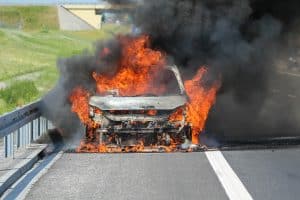Two People Are Alive After a Car Fire Because of an IDOT Minuteman
 We don’t get to talk about “good stuff” the Illinois Department of Transportation (IDOT) does all that often. To be fair, most folks don’t.
We don’t get to talk about “good stuff” the Illinois Department of Transportation (IDOT) does all that often. To be fair, most folks don’t.
But today, we want to share the best story we’ve heard in a very long time. Per ABC News:
An IDOT worker helped save two people after their car crashed and burst into flames Friday morning on the Kennedy Expressway.
“The whole car was filled with smoke,” IDOT worker Steve Newcomb. “By the time I got them to the shoulder and everything and the fire came and pulled up, the whole car was in flames.”
Newcomb was driving along the Kennedy for IDOT around 2 a.m., when a Toyota Camry heading inbound near Addison Street hit a wall and caught fire.
“I saw the flames and I moved up to push the car from underneath the bridge,” Newcomb said. “And that’s when I saw the people inside the car moving around.”
He acted quickly pulling two women out of the car to safety, before state police and firefighters could get there.
Steve Newcomb was in a tow truck when he came across that wreck. He was going about his business as a tow truck driver, putting up flares and trying to move a car out of the danger zone, when he realized the car wasn’t empty. And then he just… saved two people’s lives.
Both of those women are alive today because of Steve Newcomb. So before we talk about literally anything else today, we want to highlight his heroism. ABC News made a point to say that Steve won’t call himself a hero, but clearly we will. And we bet those women will, too.
That said, there were some other things about this story that caught our attention.
First: What’s a Minuteman, exactly?
If you looked at our blog (or the ABC News story) and immediately thought of the American Revolution, we wouldn’t blame you. The Minutemen were members of militias who “provided a highly mobile, rapidly deployed force that enabled the colonies to respond immediately to military threats.” In almost all modern uses of the word, “Minutemen” refers to fighting.
But IDOT focuses on why they were Minutemen in the first place – the ability to move fast. From the IDOT website:
The primary objective of the [Emergency Traffic Patrol and Emergency Patrol Vehicle] ETP/EPV workers, also referred to as “Minutemen,” is to respond to all disruptive incidents on the state’s busiest urban expressway systems and to take immediate corrective action to safely restore normal traffic flow. Minutemen then execute help that motorists need when breakdowns or mishaps occur.
“Minutemen then execute help that motorists need when breakdowns or mishaps occur.” These are the folks that run toward danger instead of away from it. And that danger includes car fires.
Next: How common are car fires in Chicago, anyway?
In his interview, Newcomb talked about how this was a once-in-a-lifetime experience for him. As he said to ABC News, “I mean, I’ve seen tons of cars on fire, but I’ve never physically pulled anybody out of a burning car to this point.”
And we thought, What do you mean you’ve seen “a ton” of car fires? How many cars are on fire in Chicago?
As it turns out, quite a few. Aside from the car fire early this morning:
- February 22, 2024: a Chicago Police Department vehicle burst into flames.
- February 21, 2024: what appears to be a rear-end crash in Skokie causes a vehicle to burst into flames.
- January 18, 2024: an electric vehicle catches fire while parked in a parking garage at the Fashion Outlets of Chicago mall.
- December 3, 2023: a drunk driver hits a building on North Sheridan Road and catches on fire.
- July 22, 2023: an SUV hits a median on the southbound Tri-State and catches fire.
- May 10, 2023: a car catches fire on DuSable Lake Shore Driver.
In most of these cases, the cars caught fire after a crash.
But why did the vehicles catch fire in the first place?
If you look at what happened this morning as well as most of the stories about some of the other car fires, you’ll see that each of them hit something – a barrier, a median, another car. Now, when modern cars hit other objects, they tend to fall apart; that happens by design, you know. Crumple zones specifically take the impact so that the bodies in the car do not.
But when cars hit at a significant enough speed (even if they’re traveling at a legal speed), they can crack the fuel lines, damage electrical wires, and cause oil, coolant, or other flammable liquids to leak. Take a flammable liquid and add a spark from an electrical wire, and next thing you know – car inferno.
Finally: We should be better to tow truck drivers in general
The number we see the most is 60: on average, 60 tow truck drivers are killed by other vehicles every year. According to the most recent data from the AAA Foundation for Traffic Safety, though, that number is finally trending down. Their 2024 report on fatal accidents involving Roadside Assistance Providers (RAPs) showed that in 2021, there were 26 fatal accidents involving RAPs, meaning the number dropped by half. (Whether this is a true account or an affect of the pandemic remains to be seen, but we’re hoping it’s real.)
Per their data, most RAPs were struck by folks in SUVs, vans, and pickups, and a third of all striking drivers tested positive for alcohol. Most of the drivers were middle aged, and all of them were men.
Now, we can’t ban middle-aged men from being roadside assistance providers, of course (nor should we, or we’ll lose Steve Newcomb), but we CAN do more to help RAPs like tow-truck drivers and other emergency services personnel:
- Follow the Move Over laws. In Illinois, it’s known as “Scott’s Law,” but every state has some version of them. It’s a pretty hefty fine for violating the law, but the better reason to follow it is that it saves lives.
- Carry flares or LED signal lights. You should keep these in your trunk just in case, but if you’re waiting for a tow, set up the lights anyway. It may force other drivers to slow down even if they don’t notice the giant tow truck.
- Call your local aldermen and representatives. Make sure they know you support funding for emergency roadside services. IDOT puts a lot of miles on their tow trucks, and all that mileage can wear trucks out fast. Pledge your support for newer vehicles with better safety technology to replace any older vehicles.
All of us at Gainsberg Injury and Accident Lawyers were thrilled to hear that the women in that car were safe, thanks to the work of one extraordinary Chicago minuteman. We know how much worse the news could have been. If you or your loved one is injured in a car accident in Chicagoland, let us help. Please call us or fill out our contact form to schedule a free consultation.

Attorney Neal Gainsberg has spent the last 20+ years fighting to protect the rights of the injured in Chicago and throughout Illinois. For dedicated legal help with a personal injury, car accident, or wrongful death matter, contact Gainsberg Injury and Accident Lawyers in Chicago for a free consultation.
